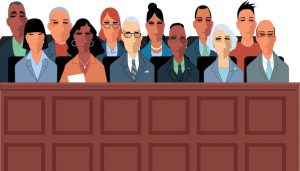- August 7, 2018
- Michael Mayer
- business litigation

In Elsner v. Birchall, M.D., 8th Dist. Cuyahoga No. 106524, 2018-Ohio-2521, the Ohio Court of Appeals addressed whether the fact that a juror had previously been represented by the law firm representing the prevailing party amounted to juror misconduct. The answer: not always. Perhaps more importantly for practitioners, the case shows that attorneys need to be especially diligent in ferreting out a juror's potential bias during voir dire.
As background, the jury in Elsner returned a verdict in favor of the defendant. On appeal, the plaintiff argued that the trial court should have awarded him a new trial because one of the jurors failed to disclose that she was previously represented by the same law firm that represented the defendant. The court summarized the situation:
"[D]uring voir dire, the court introduced both parties…as well as the parties' attorneys, and asked the jurors if they knew or recognized any of them. None of the jurors indicated that they did. During those introductions, the court did not identify the law firms where the attorneys worked. Later, the court asked whether any of the jurors had been involved in a medical malpractice case, to which juror No. 2 indicated she had. Juror No. 2, who was an adult nurse practitioner at the Cleveland V.A. Medical Center, explained, 'I have been deposed numerous times in cases as part of hospital staff. I was not named in them. I was named along with the physician in private practice. It was a malpractice suit for a patient in a nursing home. The family brought suit. We were dismissed from the case.' Despite this, juror No. 2 informed the trial court that she could be fair and impartial to both sides. Although not precluded from doing so, neither [party's] counsel further questioned juror No. 2 as to those lawsuits." Id. at ¶16-17.
The appellate court set forth the two-step process for finding juror misconduct. "First, a trial court must determine whether misconduct actually occurred. If the trial court finds misconduct, then it must determine if the misconduct materially affected the complaining party's substantial rights." Id. at ¶12. The plaintiff failed to establish either requirement.
The appellate court held that "[c]ounsel's prior representation of a prospective juror does not always constitute grounds for a for-cause challenge." It explained that, in the case at hand, "there is no proof in the record that juror No. 2 answered any of the voir dire questions asked by the trial court or by counsel dishonestly," and "the information that was potentially prejudicial to [plaintiff's] case could have properly been examined during voir dire." The court also explained that "the overriding purpose of voir dire is to question prospective jurors and determine whether a potential juror meets both the statutory qualification of a juror and is free from bias or prejudice for or against either litigant. Counsel is in the best position to determine whether any potential juror should be questioned and to what extent." Yet, "[c]ounsel failed to question Juror No. 2 as to her prior counsel during the lawsuit which she referenced." Counsel also "did not ask juror No. 2 the name of the law firm or of the individual attorneys that represented her and did not challenge juror No. 2 after voir dire." Id. at ¶19-22.
The appellate court did recognize that, although they were from the same law firm, the attorney who represented the defendant at the trial was not the same attorney who represented juror No. 2 in a medical malpractice case. It is unclear whether the outcome of the appeal would have been different if they were the same lawyer, although one would expect that the juror in that situation would have indicated that she recognized the attorney. Regardless, Elsner is a good reminder to litigators that courts expect trial counsel -- and not judges -- to comprehensively question potential jurors to expose potential bias or other reasons to challenge or disqualify a juror.
